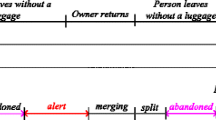Abstract
This paper proposes a novel method for the detection of vandalism events in video sequences. The method is based on a proposed definition for common vandal behaviors recorded on surveillance video sequences. To do this, the method monitors changes inside a restricted site containing vandalism-prone objects such as a vending machine, a pay phone, or a street sign. When an object is detected as leaving such a site, the proposed method checks if the site contains temporally consistent and significant static changes, representing damage. If there are such changes and given that the site is normally unchanged after legal use, a vandalism event is declared and the vandals are tracked. The proposed method is tested on video sequences showing real and simulated vandal behaviors and it achieves a detection rate of 96%. It detects different forms of vandalism such as graffiti and theft, and can handle sudden illumination changes, occlusions, and segmentation errors. The proposed method operates at a frame rate of 13 frames per second.




















Similar content being viewed by others
References
Achkar F, Amer A (2007) Hysteresis-based selective gaussian mixture models for real-time background maintenance. SPIE Vis Commun Image Process 6508:J1–J11
Allen P, Feiner S, Meskell L, Ross K, Troccoli A, Smith B, Benko H, Ishak E, Conlon J (2004) Digitally modeling, visualizing and preserving archaeological sites. In: Proc. joint ACM/IEEE conf. on digital libraries, p 389
Amer A (2005) Voting-based simultaneous tracking of multiple video objects. IEEE Trans Circuits Syst Video Technol 15:1448–1462
Angiati D, Gera G, Piva S, Regazzoni C (2005) A novel method for graffiti detection using change detection algorithm. In: Proc. IEEE conf. advanced video and signal based surveillance, pp 242–246
Barker M, Bridgeman C (1994) Preventing vandalism: what works? Police research group, crime detection and prevention series: paper no. 56, pp 1–3
Candamo J, Shreve M, Goldgof DB, Sapper DB, Kasturi R (2010) Understanding transit scenes: A survey on human behavior-recognition algorithms. IEEE Trans Intell Transp Syst 11(1):206–224
Chan TSK, Chung KSM (2008) Applications and selections of intelligent surveillance system in railway industry. In: International conference on challenges for railway transportation in information age, pp 1–6
Chee BC, Lazarescu M, Tan T (2007) Detection and monitoring of passengers on a bus by video surveillance. In: Proc. int. conf. image analysis and process, pp 143–148
Cupillard F, Avanzi A, Bremond F, Thonnat M (2004) Video understanding for metro surveillance. In: Proc. IEEE int. conf. networking, sensing and control, pp 186–191
di Stefano L, Tombari F, Lanza A, Mattoccia S, Monti S (2008) Graffiti detection using two views. In: The eighth int’l workshop on visual surveillance, vol 1
Ghazal M, Vazquez C, Amer A (2007) Real-time automatic detection of vandalism behavior in video sequences. IEEE conf. on systems, man and cybernetics, pp 1056–1060
Ivanov Y, Bobick A (2000) Recognition of visual activities and interaction by stochastic parsing IEEE Trans Pattern Recognit Mach Intell 22(8):852–872
Krausz B, Herpers R (2010) Metrosurv: detecting events in subway stations. Multimed Tools Appl 50(1):123–147
Ma J, Liu W, Miller P, Yan W (2009) Event composition with imperfect information for bus surveillance. In: IEEE international conference on advanced video and signal based surveillance, pp 382–387
Nguyen NT, Bui HH, Venkatesh S, West G (2003) Recognising and monitoring high-level behaviour in complex spatial environments. IEEE int conf on computer vision and pattern recognition, pp 1–6
Ning N, Tan T (2006) A framework for tracking moving target in a heterogeneous camera suite. In Proc. int. conf. control, automation, robotics and vision, pp 1–5
Oates T, Schmill MD, Cohen PR (2000) A method for clustering the experiences of a mobile robot with human judgments. In: Proc. of the 17th national conf. on artificial intelligence and twelfth conf. on innovative applications of artificial intelligence, pp 846–851
Sacchi C, Regazzoni C, Gera G, Foresti G (2001) Use of neural networks for behavior understanding in railway transport monitoring applications. In: Proc. int. conf. image process, pp 541–544
Sacchi C, Regazzoni C, Vernazza G (2001) A neural network-based image processing system for detection of vandal acts in unmanned railway environments. In: Proceedings of the 11th international conference on image analysis and processing, 2001, pp 529–534
Sauvé J (2004) Crime statistics in canada. Statistics Canada—catalogue no. 85-002-XPE, vol 25, no 5
Tombari F, Di L, Stefano Mattoccia S, Zanetti A (2008) Graffiti detection using a time-of-flight camera, pp 645–654. Springer, Berlin/Heidelberg
Valera M, Velastin SA (2005) Intelligent distributed surveillance systems: a review. IEE P-Vis Image Sign 152(2):192–204
Vazquez C, Ghazal M, Amer A (2008) Feature-based detection and correction of occlusions and split of video objects. SIViP 3(1):13–25
Weiming H, Tieniu T, Liang W, Maybank S (2004) A survey on visual surveillance of object motion and behaviors. IEEE Trans Syst Man Cybern 34(3):334–352
Author information
Authors and Affiliations
Corresponding author
Additional information
This work was supported, in part, by the Natural Sciences and Engineering Research Council (NSERC) of Canada.
Rights and permissions
About this article
Cite this article
Ghazal, M., Vázquez, C. & Amer, A. Real-time vandalism detection by monitoring object activities. Multimed Tools Appl 58, 585–611 (2012). https://doi.org/10.1007/s11042-011-0751-z
Published:
Issue Date:
DOI: https://doi.org/10.1007/s11042-011-0751-z




